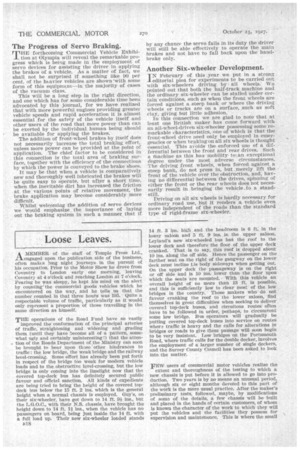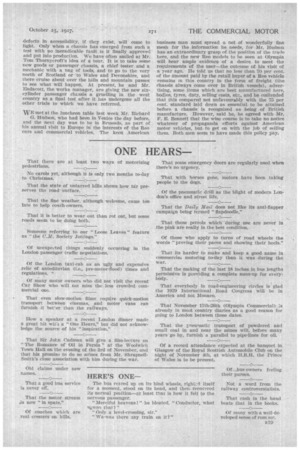Loose Leaves.
Page 44

Page 45

If you've noticed an error in this article please click here to report it so we can fix it.
A MEMBER of the -staff of Temple Press Ltd., 1-1_ engaged upon the publication side of the business, often makes long night journeys in the pursuit of his occupation. Prior to the Motor Show he drove from Coventry to London early one morning, leaving Coventry. at 4 o'clock and reaching LonclOn at 7 o'clock. Fearing he was sleepy, he kept his mind on the alert by countingithe commercial goods vehicles which he encountered on the way, and he tells us that the number counted in that three bouts was 195. Quite a respectable volume of traffic, particularly as it would only represent a proportion of those travelling in the same direction as himself.
THE operations of the Road Fund have so vastly
improved the conformation of the principal arteries of traffic, straightening and widening and grading them (until they have become all of a pattern, somewhat ugly and certainly uninteresting!) that the attention of the Roads Department of the Ministry can soon be brought to bear upon those other hindrances to traffic: the low bridge, the weak bridge and the railway level-crossing. Some effort has already been put forth in respect of the bridge too weak for modern vehicle loads and to the obstructive level-crossing, but the low bridge is only coming into the limelight now that the covered top-deck bus has definitely secured public favour and official sanction. All kinds of expedients are being tried to bring the height of the covered topdeck bus below the 15 ft. 2 ins, which is the general height when a normal chassis is employed. Guy's, on their six-wheeler, have got down to 14 ft. 9i. ins., but the L.G.O.C., with their N.S. chassis, have brought the height down to 14 ft. 1f ins., when the vehicle has no passengers on board, being just inside the 14 ft. with a full load up. Their new six-wheeler loaded stands
EIS
14 ft. 3 ins, high and the headroom is 6 ft. in the lower saloon and 5 ft. 9 ins. in the upper saloon. Leyland's new six-wheeled bus has the roof to the lower deck and therefore the floor of the upper deck cranked. That is to say, this roof is dropped about 10 ins, along the off side. Hence the passenger on the farther seat on the right of the gangway on the lower deck must incline Lis body sideways when getting out. On the upper deck the passageway is on the right or off side and is 10 ins, lower than the floor upon which the seats are mounted.. With this vehicle an overall height of no more than 13 ft. is possible, and this is sufficiently low to clear most of the low bridges in the country. Those makers who do not favour cranking the roof to the lower saloon, find themselves in great difficulties when seeking to deliver coverei top-deck buses, and circuitous routes often have to be followed in order, perhaps, to circumvent some low bridge. BIM operators will •gradually be putting covered top-deck buses into service on routes where traffic is heavy and the calls for alterations in bridges or roads to give them passage will soon begin to be very insistent. Low bridges on the Portsmouth Road, where traffic calls for the double decker, involves the employment of a larger number of single deckers, and the Surrey County Council has been asked to look into the matter.
FEW users of commercial motor vehicles realize the extent and thoroughness of the testing to which a new chassis is put before it is allowed to go into production. Two years is by no means an unusual period, although six or eight months devoted to this part of the work is the more usual practice. After the maker's preliminary tests, followed, maybe, by modifications of some of the details, a few chassis will be built and placed in the hands of certain customers, of whom Is known the character of the work to which they will put the vehicles and the facilities they possess for supervision and maintenance. This is where the small
defects in accessibility, if they exist, will come to light. Only when a chassis has emerged from such a test with no ineradicable fault is it finally approved and put into production. We have often smiled at Mr. Tom Thornycroft's idea of a tour. It is to take some new goods or passenger chassis, a chief tester and a mechanic with a nag of tools, and to go to the very north of Scotland or to Wales and Devonshire, and there cruise about over the hills and mountain passes to see what will happen. At present, he and Mr. Endarott, the works manager, are giving the new sixcylinder passenger chassis a gruelling in the west country as a final test after it has undergone all the other trials to which we have referred.
WE met at the luncheon table last week. Mr. Richard
G. Hudson, who had been in Venice the day before, and the next day was to he in Brussels, as part of his annual visit to Europe in the interests of the Reo cars anti commercial vehicles. The keen American
business man must spread a net of wonderfully fine mesh for the information he needs, for Mr. Hudson has an extraordinary ,grasp of the position of the trade here, and the new Reo models to be seen at Olympia will bear ample evidence of a desire to • meet the requirements of the user—the outcome of his visit of a year ago. He told us that no less than 70 per cent. of the amount paid by the retail buyer of a Reo vehicle remains in this country in the form of freight (the chassis always come over in British vessels), advertising, some items which are best manufactured here, bodies, tyres, (bitty, selling costs, etc., and he con:tended that this compared not unfavourably with the 75 per cent. standard laid down as essential to be attained before a chassis is recognized as being of British manufacture. However, said he, he agreed with Mr. F. E. Bennett that the wise course is to take no notice whatever of propaganda efforts against American motor vehicles, but to get on with the job of selling them. Both men seem to have made this policy pay.




















































































































